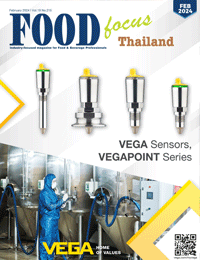การบริหารธุรกิจครัวกลาง ตัวช่วยสู่ร้านอาหารแฟรนไชส์ Managing a Central Kitchen; A Key Aide for Franchise Restaurants
1891 Views |

By: ดร. จันทร์จนา ศิริพันธ์วัฒนา
Chanchana Siripanwattana, Ph.D.
Suan Dusit Home Bakery Manager
Suan Dusit University
chanchana_sir@dusit.ac.th


ครัวกลาง (Central kitchen) เป็นสถานที่จัดเตรียมวัตถุดิบอาหาร ตลอดจนการบรรจุเพื่อกระจายสินค้าไปยังสถานที่ต่างๆ เช่น ร้านอาหาร โรงอาหาร หรือห้องครัวสำหรับโรงพยาบาล เนื่องจากห้องครัวเหล่านี้ มักจำเป็นที่จะต้องใช้สูตรและกระบวนการผลิตที่ได้มาตรฐาน โดยระบบครัวกลางเป็นระบบบริหารจัดการในรูปแบบการผลิตอาหารที่แยกสถานที่ออกมาต่างหากก่อนที่จะมีการกระจายสินค้าไปยังแต่ละสาขา
ประโยชน์ของการนำครัวกลางมาประยุกต์ใช้เพื่อความสำเร็จของธุรกิจแฟรนไชส์
1. ช่วยประหยัดต้นทุน
2. เสริมความมั่นใจในคุณภาพที่สม่ำเสมอ
3. เพิ่มประสิทธิภาพในการบริหารจัดการ
4. สร้างความยืดหยุ่นของเมนูอาหาร
5. ส่งเสริมความปลอดภัยของอาหาร
ขั้นตอนการวางแผนและออกแบบครัวกลางอย่างมีประสิทธิภาพ
ครัวกลางถือเป็นเครื่องมืออันทรงพลังที่ช่วยสร้างข้อได้เปรียบให้กับธุรกิจอาหารทั้งในแง่ต้นทุน ประสิทธิภาพการผลิต และความสม่ำเสมอของคุณภาพอาหาร โดยมีขั้นตอนการวางแผนและการออกแบบระบบครัวกลาง ดังนี้
1. กำหนดวิสัยทัศน์
2. ดำเนินการวิจัยตลาด
3. พัฒนาแผนธุรกิจ
4. ขอใบอนุญาตที่จำเป็น
ข้อกำหนดด้านกฎระเบียบถือเป็นอีกหนึ่งเรื่องที่ผู้ประกอบการต้องศึกษาข้อมูล เพื่อทำการขอรับใบอนุญาตที่เกี่ยวข้องกับการผลิตอาหาร การสุขาภิบาล และการดำเนินธุรกิจ ตลอดจนการปฏิบัติตามกฎระเบียบด้านความปลอดภัยของอาหารและการตรวจสุขภาพของบุคลากรที่จำเป็น
5. จัดหาสถานที่ที่เหมาะสมสำหรับการจัดตั้งครัวกลาง
โดยต้องเลือกสถานที่ที่มีพื้นที่เพียงพอต่อการจัดเตรียม จัดเก็บ และขนส่งอาหาร รวมไปถึงมีการเจรจาสัญญาเช่าหรือข้อตกลงที่เหมาะสมกับงบประมาณและความต้องการในการดำเนินงาน หลังจากนั้นจึงมีการจัดเตรียมอุปกรณ์และเครื่องมือต่างๆ ที่จำเป็นจะต้องใช้ในการผลิตอาหาร
6. ติดตั้งระบบในครัวกลาง
การลงทุนกับอุปกรณ์ครัวที่มีคุณภาพสูงจำเป็นอย่างยิ่งในการประกอบอาหารเชิงพาณิชย์ ซึ่งพิจารณาได้จากเมนูอาหารและปริมาณการ
7. สร้างทีมงานที่มีประสบการณ์
8. พัฒนาสูตรและกระบวนการให้ตรงตามมาตรฐาน
โดยจัดการฝึกอบรมพนักงานให้ปฏิบัติงานตามมาตรฐาน ไม่ว่าจะเป็นคู่มือขั้นตอนการปรุง ระเบียบการด้านสุขอนามัย และมาตรการควบคุมคุณภาพ รวมทั้งต้องมีการติดตามและทวนสอบผลการปฏิบัติงานอย่างสม่ำเสมอ
9. สร้างระบบการกระจายสินค้าและโลจิสติกส์
การจัดทำระบบครัวกลางควรเลือกใช้วิธีการขนส่งสู่ร้านสาขาที่เหมาะสม ทั้งยังต้องตรวจสอบการเลือกใช้บรรจุภัณฑ์และการควบคุมอุณหภูมิสินค้าให้มีความเหมาะสม รวมถึงต้องมีการพัฒนาเส้นทางและกำหนดระยะเวลาในการจัดส่ง
10. ส่งเสริมการตลาดและสร้างการรับรู้แบรนด์
11. ลงทุนกับเทคโนโลยีและข้อมูลเชิงลึก
12. ปฏิบัติตามกฎระเบียบด้านความปลอดภัยอาหารและความยั่งยืน
โดยการฝึกอบรมพนักงานเกี่ยวกับหลักปฏิบัติด้านสุขอนามัย และมีการตรวจสอบเป็นประจำ นอกจากนี้ยังต้องมีการปฏิบัติตามแนวทางความยั่งยืน
A central kitchen is where raw materials and food ingredients are prepared and packed before distributing to various locations such as restaurants, cafeterias, or hospital kitchens. The central kitchen system is a management system in which food production is operated in separate locations before distributing prepared products to each branch, as they often require standardized recipes and consistent production processes.
Benefits of central kitchen concept to support franchisees
1. Cost savings
2. Enhance confidence due to consistent quality
3. Enhance management efficiency
4. Create flexibility for menu items
5. Promote food safety
Processes for the planning and designing of an efficient central kitchen
A central kitchen is a powerful tool that supports food businesses' cost advantages, production efficiency, and consistency of food quality. The steps for planning and designing an efficient central kitchen system are as follows:
1. Create the company’s vision
2. Conduct market research
3. Develop a business plan
4. Apply for the necessary permits
Regulatory requirements are another matter that entrepreneurs must focus on and apply for licenses related to food production, sanitation, and business operations, as well as compliance with food safety regulations and health checks of the necessary personnel.
5. Find a suitable location for a central kitchen
Ideal locations should have sufficient space to prepare, store, and transport. Leases or agreements must be negotiated to suit the budget and operational needs. Thereafter, various equipment and tools required for food production must also be sourced.
6. Install an efficient system for the central kitchen
Investing in high-quality kitchen equipment is essential for any commercial kitchen. This can be determined from the food menu and production volume.
7. Build an experienced team
8. Develop recipes and processes to meet standards
Entrepreneurs should organize training for their staff to work according to the established standards. Whether for a cooking process manual, sanitation regulations, or quality control measures. Additionally, regular monitoring and inspections also need to be conducted to verify consistent performance.
9. Create an efficient distribution and logistics
Establishing a central kitchen system also requires an appropriate delivery process to the branches. Moreover, the selection of packaging and product temperature control should be appropriate to the foods, including the need to develop routes and schedule delivery times.
10. Promote marketing and create brand awareness
11. Invest in technology and insights
12. Comply with food safety regulations and sustainability
Entrepreneurs should organize training for their employees regarding hygiene practices and conduct reviews of their practices on a regular basis. It also requires adherence to sustainability guidelines.




